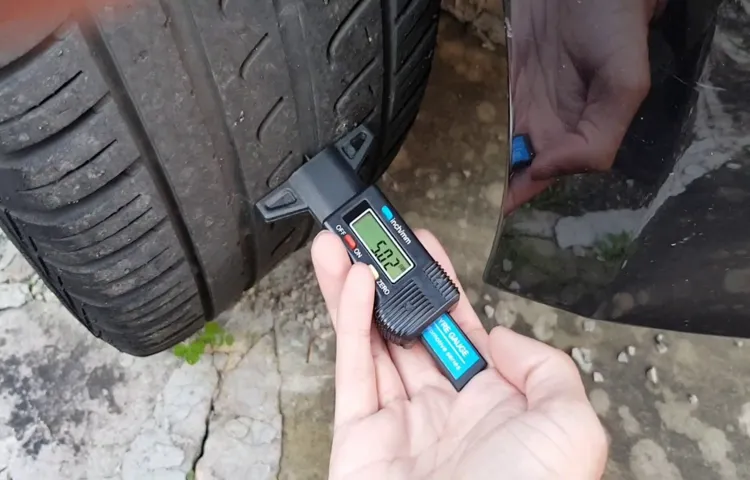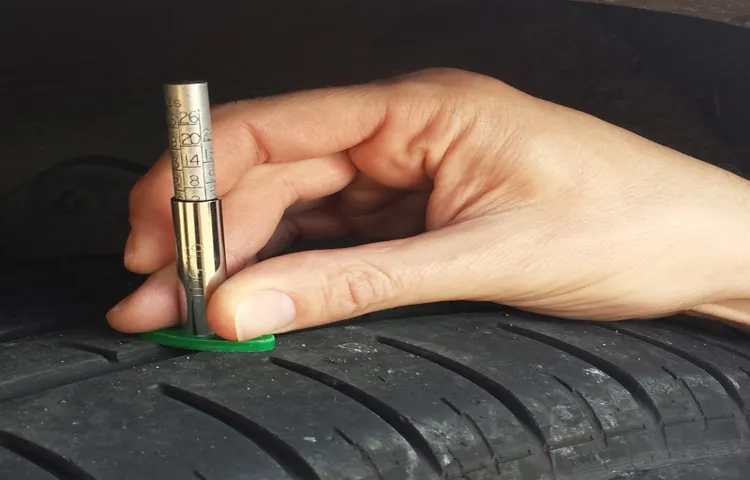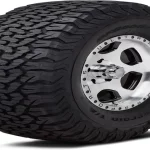Have you ever wondered how to measure the tread depth on your car’s tires? Using a tire depth gauge is a simple and effective way to determine if it’s time to replace your tires. This handy tool allows you to accurately measure the depth of the grooves on your tires, which is crucial for maintaining proper traction and avoiding accidents on the road. Imagine driving on a wet or slippery road with tires that have worn down treads.
It’s like wearing shoes with no grip – you’re more likely to slip and fall. The same goes for your tires; worn-down treads can compromise your car’s handling and braking, especially in wet or icy conditions. That’s why it’s essential to keep an eye on your tire’s tread depth and replace them when necessary.
In this blog, we’ll explore how to use a tire depth gauge, what to look for when measuring your tire’s tread depth, and why it’s crucial to maintain proper tire tread. We’ll also share tips on how to extend the life of your tires and when to have them professionally inspected. Ready to learn how to check your tires’ tread depth? Let’s dive in!
Table of Contents
What is a Tire Depth Gauge?
If you’re a car owner, it’s important to maintain your vehicle’s tires. One essential tool for this task is the tire depth gauge. It’s a simple device that measures the depth of your tire’s grooves, commonly known as treads.
These treads provide your tires with traction on the road and prevent your vehicle from skidding or slipping. By using a tire depth gauge, you can check if your tire treads are deep enough to be safe for you to drive on. To use a tire depth gauge effectively, simply press its probe into the grooves of the tire tread and measure the depth.
It’s recommended to measure the depth in several places across the tire tread to get an accurate reading. If the depth is less than the recommended minimum, it’s time to replace the tire before hitting the road. A tire depth gauge is a handy tool that can save you from accidents caused by worn-out tires.
Definition and Importance of Tire Tread Depth
Tire depth gauge is a simple device that measures the depth of the grooves on your tire tread. It is an essential tool for every driver because it accurately indicates when your tires need to be replaced. The tread on your tire provides grip, which is essential for safe driving, particularly in poor weather conditions.
When you regularly check your tire tread depth, you can detect any signs of wear and tear and take action to replace your tires early before they become dangerous. Over time, tires lose their tread depth and become smooth, increasing the risk of skidding and losing control of your vehicle. A tire depth gauge is an easy-to-use tool that you can keep in your car for simple maintenance checks to ensure your safety on the road.
Don’t take chances with your safety when driving. Check your tire tread depth with a tire depth gauge regularly.

Steps for Using the Tire Depth Gauge
If you want to check the depth of your tire treads, you’ll need a tire depth gauge. But how do you use it? First, ensure your tires are dry and cool. Insert the gauge into the groove of the tire, making sure it’s touching the base.
Take note of the measurement displayed on the gauge. Repeat this process at several different points around the tire to make sure you obtain an accurate average reading. If the reading is at or below 2/32 of an inch, it’s time to replace your tires.
Don’t forget to take into account the kind of driving you do, as well as the weather and road conditions in your area, as you may need to replace your tires sooner. Regularly checking your tires’ treads with a depth gauge is essential to keep you and others safe on the road.
Step 1: Select the Right Gauge
When it comes to measuring tire depth, selecting the right gauge is the first step. Not all gauges are created equal and there are a few different types to choose from. The most common type is the pen-type gauge, which features a plastic or metal probe that is inserted into the groove of the tire to measure the depth.
Another type is the dial-type gauge, which incorporates a clock-like face that displays the depth measurement. Regardless of which type you choose, make sure to select a gauge that is accurate, easy to read, and well-suited for your needs. Once you have the right gauge, it’s time to move on to the next step in the process of measuring tire depth.
Step 2: Measure the Tread Depth
When it comes to checking the tread depth of your tires, a tire depth gauge can come in handy. To use it properly, there are a few steps you should follow. After locating the tread wear indicator bars or checking the wear on the tire manually, the next step is to measure the tread depth using the gauge.
This step is vital as it determines the overall health of your tire and how much wear and tear it has endured. The gauge will have a small probe that you will insert into the grooves of the tire. Once you push it down firmly, the gauge will reveal the tread depth in millimeters or inches.
It’s essential to measure the tread depth at different points across the tire to ensure an accurate reading. If you’re using a digital gauge, you’ll get an instant reading, making the process quick and effortless. However, if you’re using a manual gauge, you’ll need a ruler to measure the gap between the tread blocks’ highest point and the base of the gauge.
By measuring the tread depth, you can tell if your tires require a replacement or if they’re still safe for the road.
Step 3: Check the Tread Wear Indicators
When it comes to checking your tire’s health, using a tire depth gauge is an essential step. But what do you do after you’ve measured the tread depth? That’s when you need to move on to the next step: checking the tread wear indicators. These are small rubber blocks within the tire’s tread that become exposed as the tire wears down.
If you can see these wear indicators, that means your tire is worn out and needs to be replaced. Keep an eye out for any cracks, bulges or deformities in the tread as well, as these indicate serious damage and could cause a blowout or flat tire. By keeping up with regular tire maintenance, you can avoid costly repairs and stay safe on the road.
Benefits of Regularly Measuring Your Tire Tread Depth
Knowing how to use a tire depth gauge can save you from potential road hazards and accidents. Regularly measuring your tire tread depth is crucial as it can affect the performance of your vehicle and your overall driving experience. It helps determine the level of traction and grip your tires have, especially on wet and slippery roads.
A tire depth gauge lets you know when it’s time to replace your tires, preventing potential blowouts, hydroplaning, and skidding accidents. Moreover, measuring your tire tread depth can also save you money in the long run as worn-out tires increase fuel consumption, affecting your vehicle’s mileage. By measuring the tire depth gauge regularly, you can stay on top of your tire maintenance and make sure your car is always roadworthy.
Extended Tire Life
Regularly measuring your tire tread depth has a host of benefits, the most significant being extended tire life. By keeping track of your tire’s tread depth, you can ensure that it never falls below the minimum required level, which will help prolong its life and save you money in the long run. When tires are worn out, they become less effective at gripping the road, which increases the risk of accidents, especially when driving in wet or snowy conditions.
Regular tread depth checks can help you identify when it’s time to replace your tires, which will help you maintain your vehicle’s safety and performance. So, instead of risking your safety and running up unnecessary expenses, take the time to measure your tread depth regularly. It’s a small investment that will pay off in huge dividends in the long run.
Improved Safety on the Road
Regularly measuring your tire tread depth is essential for improved safety on the road. Your tire tread depth affects the distance it takes to stop your car, the stability of your vehicle on wet or slippery roads, and the likelihood of hydroplaning. A simple way to measure your tire tread depth is by using a coin – place a penny into the tread groove, and if you can see the top of Lincoln’s head, it’s time to replace your tires.
Regularly checking your tire tread depth can prevent accidents and save you money in the long run, as well-maintained tires last longer. Don’t wait until it’s too late, make tire maintenance a regular part of your driving routine.
Better Gas Mileage
When it comes to getting better gas mileage, many drivers don’t realize that regularly measuring their tire tread depth can make a big difference. Over time, as your tires wear down, your vehicle has to work harder to maintain traction, which can lead to decreased fuel efficiency and more frequent trips to the gas pump. By monitoring your tread depth and replacing your tires when necessary, you can ensure that your car is always running at its best and getting the most out of every gallon of gas.
Plus, by taking care of your tires, you’ll be doing your part for the environment by reducing your carbon footprint and conserving valuable resources. So why wait? Start measuring your tread depth today and enjoy the many benefits of better gas mileage!
Conclusion
So, now that you have obtained a tire depth gauge, what do you do with it? Firstly, make sure you have clean and dry tires – no mud, no water, no debris. Secondly, simply insert your gauge into the tread groove and take the reading – easy peasy, lemon squeezy! But remember, don’t just stop at one reading – take multiple readings around the tire and take an average measurement. When you’ve finished, pat yourself on the back and admire your tire depth gauge prowess.
With the help of this little tool, you can ensure your tires stay in top shape and won’t leave you spinning out of control on the highway. Happy measuring!”
FAQs
What is a tire depth gauge and how does it work?
A tire depth gauge is a tool used to measure the depth of tire treads. It typically works by inserting a probe into the tread grooves and reading the measurement displayed on the gauge.
Why is it important to regularly check tire depth?
Tire depth is important because it directly affects tire traction and safety on the road. If the tire depth is too shallow, it can increase the risk of hydroplaning and decrease traction on wet or slippery roads.
How often should tire depth be checked?
Tire depth should be checked at least once a month and before any long road trips. It is also a good idea to check tire depth after hitting a pothole or curb, or if you notice uneven wear on the tires.
Can you use a tire depth gauge on any type of tire?
Yes, a tire depth gauge can be used on any type of tire, including car, truck, and motorcycle tires.
How do you properly use a tire depth gauge?
To use a tire depth gauge, insert the probe into the tread groove of the tire and press down firmly until it stops. Then, read the measurement displayed on the gauge. Repeat this process in multiple locations on the tire to get an accurate overall measurement.
What is the minimum legal tire depth requirement?
The minimum legal tire tread depth requirement in the United States is 2/32 inches. It is recommended to replace tires when the tread depth reaches 4/32 inches for improved safety.
Can tire depth affect fuel efficiency?
Yes, tire depth can affect fuel efficiency. Tires with deeper treads create more friction, which can lead to increased rolling resistance and decreased fuel efficiency. It is important to maintain proper tire pressure and choose tires with appropriate tread depth for your vehicle to maximize fuel efficiency.




